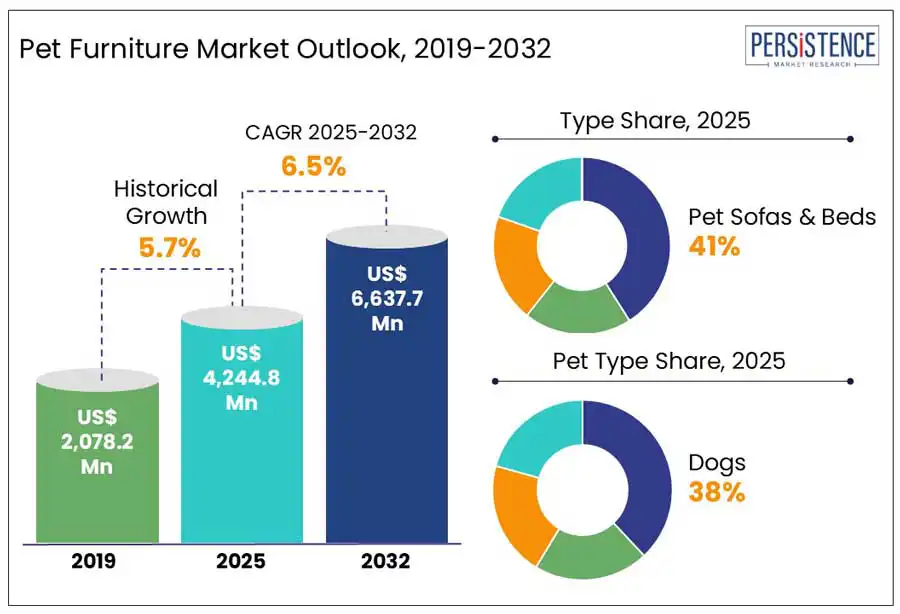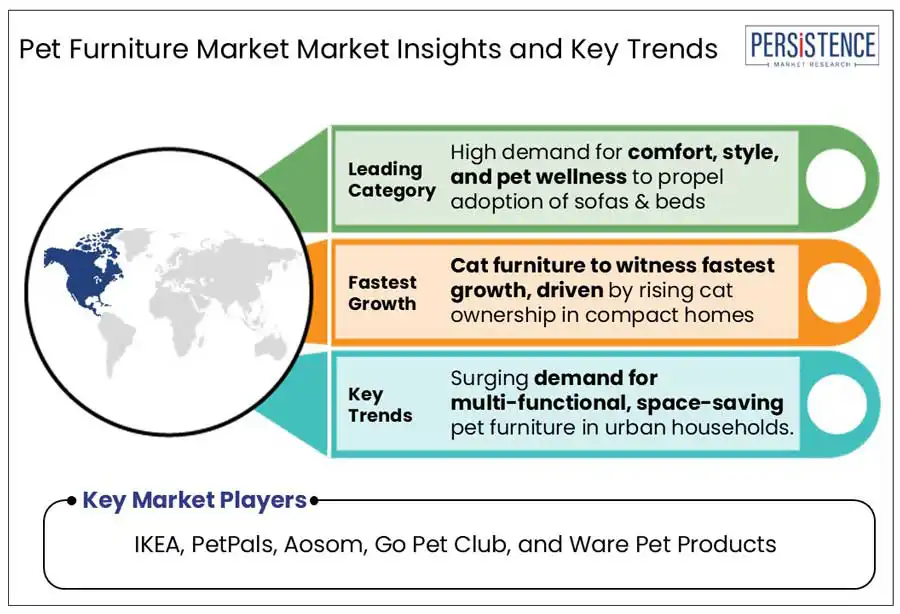Comprehensive Analysis of Pet Furniture Market Including Regional and Country Analysis in Brief.
Industry: Consumer Goods
Published Date: April-2025
Format: PPT*, PDF, EXCEL
Delivery Timelines: Contact Sales
Number of Pages: 180
Report ID: PMRREP35194
The global pet furniture market size is anticipated to be valued at US$ 4244.80 Mn in 2025. The market is projected to grow by US$ 6637.70 Mn between 2025 and 2032, at a CAGR of 6.5%.
The pet furniture industry is witnessing significant transformation as consumer behaviors shift, with new trends emerging. As we already in 2025, it is evident that the marketplace is becoming increasingly omnichannel, with more pet parents opting for online shopping. This shift presents both challenges and opportunities for pet furniture brands, as they need to adapt to meet the ever-evolving needs of pet owners. Navigating the complexities amid rising expectations, changing demographics, fluctuating category performance, and adjusting strategies accordingly will be crucial for industry players to stay competitive in this dynamic market.

Key Industry Highlights
|
Global Market Attribute |
Key Insights |
|
Pet Furniture Market Size (2025E) |
US$ 4244.80 Mn |
|
Market Value Forecast (2032F) |
US$ 6637.70 Mn |
|
Projected Growth (CAGR 2025 to 2032) |
6.5% |
|
Historical Market Growth (CAGR 2019 to 2024) |
5.7% |
Sustainable and eco-friendly designs are emerging as a key growth driver. Modern pet parents, especially millennials and Gen Z, are actively choosing products that align with environmental values. This shift is fueling demand for furniture made from materials such as bamboo, recycled wood, jute, and organic cotton. These products offer both aesthetic appeal and a lower ecological footprint. For instance, IKEA’s pet furniture line is made with sustainable materials in minimalist designs, catering to eco-conscious consumers who want their pet spaces to blend seamlessly into stylish, green homes.
The increasing demand for eco-friendly furniture has influenced both supply chain decisions and pricing strategies. Today, consumers are willing to pay a premium for sustainable products, perceiving them as a long term investment rather than a short-term purchase. Brands such as Tuft + Paw have successfully capitalized on this trend by offering modern, sustainable cat furniture that has garnered attention for form and function. Their growth demonstrates sustainability, when paired with thoughtful design can significantly boost market appeal and customer retention.
Today, 55% of world population reside in urban areas, and this figure is projected to rise to 68% by 2050, reports United Nations. As urbanization accelerates, a significant portion of the global population is transitioning to city living, leading to smaller residential spaces. Space constraints in urban living are proving to be a notable barrier to the market growth. Consumers living in compact apartments often struggle to accommodate bulky or standalone pet furniture, leading to lower purchasing intent despite a strong emotional inclination toward pet care. This hinders the adoption of large products such as pet sofas, multi-level cat trees, or dog kennels, which may not be practical in constrained spaces.
Space constraints in urban living, while a challenge, also present a significant opportunity for pet furniture manufacturers to innovate and differentiate themselves from the competition. With more consumers residing in compact homes and apartments, there is a high demand for products that are both functional and space-efficient. This opens the door for manufacturers to design multifunctional, modular, or foldable pet furniture that integrates seamlessly into modern interiors.
Some manufacturers are witnessing this huge opportunity have started introducing compact furnitures such as a coffee table that doubles as a pet bed, or wall-mounted cat perches that saves floor space. For instance, during the Melbourne Design Week 2024, Colin Chee, creative director of the Youtube channel-Never Too Small, showcased 11 multifunctional pet furniture prototypes designed for animals in small apartments.
On the basis of type, the pet sofas and beds segment is anticipated to account for 41% share in 2025 and dominate further. The growing emphasis on pet comfort, health, and pet humanization is driving demand for high-quality, comfortable, and aesthetically appealing sofas and beds. Moreover, these products offer orthopedic health support to aging pets, while providing a dedicated space to pets, reducing anxiety. The evolving consumer preferences are driving manufacturers to provide sofas and beds in various size, shapes, and materials, which makes them attractive for style conscious consumers. These factors are therefore, anticipated to drive the segment growth in the forthcoming years.
Pet houses are likely to witness considerable growth, driven by the pet owners’ high spending capacity to provide dedicated, comfortable spaces for their pets. Further, pet furniture manufacturers are introducing innovative products such as raised roofs and floor-to-ceiling glass windows, constructed from premium materials leading to the growth of the segment.
Based on pet type, the dog segment is projected to account for 38% share in 2025. The dominance is primarily due to high ownership of dogs globally. According to a data by Health for American Pet Products Association, as of 2024, 65.1 million American households owned a dog. Moreover, increase in spending by dog owners on pet-related products, especially furniture items such as dog crates, beds, and sofas due to their size and activity level is projected to boost the segmental growth.
On the other hand, the cats segment is anticipated to be the fast-growing segment during the forecast period. Although the dog ownership is high in certain countries, cats are becoming more popular. For instance, as per World Population Review, in Russia, there are approximately 23 million pet cats compared to 17 million pet dogs. Similarly, in France, there are twice as many pet cats (15.1 million) as pet dogs (7.5 million). The space constraints experienced in urban areas is projected to make cats a more practical pet choice. This is further anticipated to surge the demand for compact and multifunctional cat furniture globally.

North America is anticipated to dominate the market during the forecast period. The region is projected to hold a share of about 42% in 2025, fueled by high pet ownership rates, strong consumer spending, and a deep-rooted culture of pet humanization. Pet owners in the U.S. are more likely to invest in premium, customized, and orthopedic furniture for their pets, treating them as integral members of the family.
In the U.S., the integration of pet-friendly features into residential real estate is gaining momentum. Homeowners and developers are increasingly incorporating built-in pet amenities, such as feeding stations with pot fillers and dedicated pet bed nooks into home designs. This trend reflects a growing demand for pet furniture that seamlessly blends with home interiors, offering businesses opportunities to create customizable and integrated solutions.
Asia Pacific is projected to be the fast-growing market during the forecast period. The region’s growth is propelled by the expanding e-commerce sector, high disposable income, and growing trend of pet humanization. E-commerce has been rapidly gaining traction in the pet care sector across Asia Pacific. For instance, in 2024, online channels accounted for 44% of retail value sales in the region. Notably, South Korea and China led with online sales shares of 69% and 59%, respectively. This data indicates a strong consumer preference for purchasing pet products, including furniture, through digital platforms.
Europe is forecast to witness substantial growth in the forthcoming years. Countries such as Germany, France, and the Netherlands are witnessing high demand for pet furniture that combines functionality with minimalist aesthetics, aligning with modern European interior trends. Consumers are increasingly preferring products such as modular cat trees, elevated dog beds, and wall-mounted perches that save space while enhancing the household look. This shift is forecasted to create strong business opportunities for brands that prioritize sleek, Scandinavian-inspired design with practical utility.
The global pet furniture market is highly fragmented along with various established and lesser-known companies who adopt several competitive strategies to maintain their presence. These companies focus on creating and designing innovative multifunctional pet furniture products to cater to the evolving consumer demands. Besides, investing in research and development, partnerships, collaborations, and product innovation by companies to address growing emphasis on pet comfort is anticipated to propel the market growth during the forecast period.
|
Report Attribute |
Details |
|
Historical Data/Actuals |
2019 - 2024 |
|
Forecast Period |
2025 - 2032 |
|
Market Analysis |
Value: US$ Mn |
|
Geographical Coverage |
|
|
Segmental Coverage |
|
|
Competitive Analysis |
|
|
Report Highlights |
|
|
Customization and Pricing |
Available upon request |
By Type
By Pet Type
By Distribution Channel
By Region
To know more about delivery timeline for this report Contact Sales

The global market is projected to value at US$ 4244.80 Mn in 2025.
The market is driven by growing demand for sustainable products and rapid expansion of the e-commerce sector.
The market is poised to witness a CAGR of 6.5% from 2025 to 2032.
High demand for multifunctional furniture and rising trend of pet humanization globally are the key market opportunities or the key market opportunities.
Major players in the Pet Furniture industry include Go Pet Club, Inter IKEA Systems B.V., Ware Pet Products, Petpals Group, and Aosom LLC.